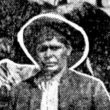Loading map...

Peter Hogan was born in the New England district of New South Wales, probably in the 1840s. He later travelled to the Darling Downs in Queensland where he was baptized. After returning to New South Wales he worked as a tracker for the police from 1864 to 1866 and was involved in the pursuit of Ben Hall’s gang of bush...
Learn More ►Charlie Hammond, son of Charlie Hammond Snr and Maria, was born on Wiradjuri country at Goolagong near Forbes in the 1870s. He was the tracker at Dubbo in 1902 and 1903. In May 1903 he helped arrest a man suspected of burning down a shed at Spicer's Creek to the east of Dubbo. The suspect's boots matched the prints at...
Learn More ►Billy Dargin was born on the Bogan River in about 1843. Nothing is known about his parents, but it was recorded at the time of his death in 1865 that he obtained his surname through working for Peter Dargin, a squatter who owned land in the Bathurst district and further west. Dargin is common Aboriginal surname from the Bogan River...
Learn More ►A distinguished tracker, John Watkins (nick-named Sir Watkin Wynne), was born about 1830, probably in Wiradjuri country between Bathurst and Forbes [ref]Sydney Morning Herald 9 August 1887: 8. I have inferred the broad area of Watkin’s birth place from the area where he is first mentioned in the historical record and the area to which he returned after retiring from...
Learn More ►James Nerang, or Jimmy as he was often known, worked as a tracker in the central-west of NSW around the turn of the 20th century. He took a prominent part in tracking Jimmy and Joe Governor after the massacre at Breelong in 1900. He was stationed at Dubbo in January 1902 when he gave evidence identifying Charles Ryan, an Aboriginal...
Learn More ►Trackers were employed at Parkes from as early as 1875 when two were sent to a nearby property to search for a lost boy. They returned five days later without success [ref]Sydney Mail and New South Wales Advertiser 2 October 1875: 425.[/ref]. The names of the trackers who worked from 1883 to 1886 are known. Alfred was the tracker in...
Learn More ►
 This website explores the history of Aboriginal trackers in NSW from 1862 when the current NSW Police Force was established through to 1973 when the last tracker, Norman Walford, retired. You can read about the lives of individual trackers and some of the incredible tracking feats they...
This website explores the history of Aboriginal trackers in NSW from 1862 when the current NSW Police Force was established through to 1973 when the last tracker, Norman Walford, retired. You can read about the lives of individual trackers and some of the incredible tracking feats they...

There were over 200 NSW police stations that employed Aboriginal trackers between 1862 and 1973. Many were concentrated in the central-west and north-west of the state, the agricultural and pastoral heartland of NSW. This is because one of the main jobs of trackers was to pursue sheep, cattle and horse thieves. Trackers sometimes lived in small huts out the back...
Learn More ►
Pathfinders book Pathfinders, A history of Aboriginal trackers in NSW, written by Dr Michael Bennett and published by NewSouth, is now available from all good bookstores. Click on the link below to order your copy. https://www.abbeys.com.au/book/pathfinders-a-history-of-aboriginal-trackers-in-nsw.do Early History Since the beginning of the colony, government agencies, explorers, surveyors and members of the general public called upon the tracking...
Learn More ►